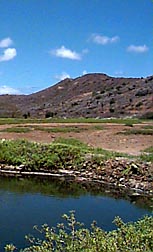The ABC islands (Aruba, Bonaire and Curaçao) were discovered by lieutenant
of Columbus, Alonso de Ojeda in 1499. De Ojeda claimed the islands for the
Spanish, but because there was
no gold there they were declared "useless islands." The native Awarak community
was largely transported to work on Hispaniola, and the island was virtually
deserted, the island remained Spanish throughout the 16th century.
 In 1634, the dutch claimed the ABC islands and founded a Dutch settlement
Curaçao's strategic position at the base
of the Caribbean was a key to make Curaçao an important trading post for the dutch
West India Company. In the 18th century Curaçao was becoming a
commercial meeting place for pirates, american rebels and merchants
Until the early 19th century, both the English and the French tried
to take Curaçao. In 1800 the English took Curaçao, but withdrew in 1803,
only to occupy it again in 1807. In 1815, the Dutch claim of Curaçao was finally
recognized by the Treaty of Paris, Dutch rule was restored and the
island was declared a free port.
In 1634, the dutch claimed the ABC islands and founded a Dutch settlement
Curaçao's strategic position at the base
of the Caribbean was a key to make Curaçao an important trading post for the dutch
West India Company. In the 18th century Curaçao was becoming a
commercial meeting place for pirates, american rebels and merchants
Until the early 19th century, both the English and the French tried
to take Curaçao. In 1800 the English took Curaçao, but withdrew in 1803,
only to occupy it again in 1807. In 1815, the Dutch claim of Curaçao was finally
recognized by the Treaty of Paris, Dutch rule was restored and the
island was declared a free port.
In the 20th century saw the Curaçao economy
prospered with the discovery of oil in neighboring Venezuela, and the subsequent
decision, in 1916 by Shell oil company to build a refinery on Curaçao because
of its political stability and its excellent port facilities. In 1954 the Netherlands
Antilles became an autonomous part of the Kingdom of the Netherlands.
The Netherlands Antilles consisted of six islands Aruba, Bonaire, Curaçao, St.
Maarten (St. Martin), St. Eustatius, and Saba. Today the Netherlands Antilles
consists of five islands since Aruba became an autonomous part of the
Netherlands Antilles in 1986.
While still part of the Dutch Kingdom, Curaçao has now focussed on tourism
as a substantial source of income besides its offshore industry.